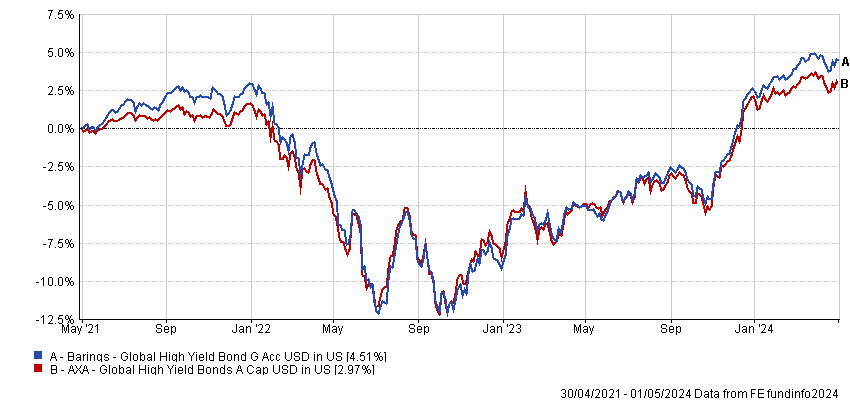
It has been a challenging environment for bond investors during the past last two years.
Following a decade of very low interest rates, then the Federal Reserve’s aggressive pivot in the opposite direction, and now expectations that rates will be higher for longer, bond strategists have yet again to refine their allocation decisions.
High yield bonds have performed well, boosted by their high coupons and yields and lower durations, as well price-recovery as recession fears diminished and the prospect of widespread defaults receded.
However, default rates are expected to be historically higher than in other years, and as an asset class, high yield competes with the attractive spreads offered by investment grade credits as well dividend-paying equities.
In this environment, a bottom-up bond selection process seems the best way to avoid surprises or being caught on the wrong side of an individual liability management refinancing or restructuring.
Against this background, Jeana Marie Doubell (pictured), manager research analyst, EMEA, chose the Axa Global High Yield Bonds fund and the Barings Global High Yield Bond fund for this week’s head-to-head comparison.
| Axa | Barings | |
| Size | $1.05bn | $2.56bn |
| Inception | 2004 | 2018 |
| Managers | Michael Graham, Robert Houle, Yves Berger, Chris Ellis | Craig Abouchar, Scott Roth, Sean Feeley, Chris Sawyer |
| Three-year cumulative return | 2.97% | 4.51% |
| Three-year annualised return | 0.96% | 1.44% |
| Three-year annualised alpha | 1.49 | 1.97 |
| Three-year annualised volatility | 6.08% | 6.07% |
| Three-year information ratio | 0.79 | 1.18 |
| FE Crown fund rating | *** | *** |
| Morningstar rating | *** | **** |
| Morningstar analyst rating | Neutral | Bronze |
| OCF (retail share class) | 1.49% | 1.33% |
Investment approach
The Axa Global High Yield Bonds fund has a structured and well-executed process that is based on capturing income from high-yield bonds while avoiding principal losses, according to Doubell. The managers follow a bottom-up, buy-and-hold approach aiming to generate returns by receiving income from the underlying bonds rather than relying on a potential rise in bond prices.
To achieve that, the team implements a barbell approach to manage risk and capture yield versus its benchmark ICE BofA Developed Markets High Yield Constrained Index. The fund combines higher yielding but lower quality (B to CCC) credits with short maturity bonds.
“This helps mitigate volatility and sets them apart from peers,” said Doubell.
Geographic allocation and sector exposure are secondary drivers, and so regional weightings are typically kept within 10% of the benchmark, roughly a split of 70% US issuers and 30% European issuers. The portfolio is well diversified as it typically includes between 250 and 350 issuers.
The process of the Barings Global High Yield Bond strategy “is well defined and team-orientated, supported by strong collaboration between its contributors,” said Doubell.
Credit selection is driven by two investment committees: one for US high yield and one for European high yield, which meet daily. Senior investment professionals vote analysts’ recommendations onto a buy list and mandate sales.
“The team perceives 150-250 issuers as a sweet spot for the portfolio, but they are not beholden to invest in names from their ICE BofA Non-Financials Developed Markets High Yield Constrained Index that they dislike, given the best-idea approach,” said Doubell.
While the process is largely bottom-up driven, top-down inputs in the form of US/European allocation targets come from the Global High Yield Allocation Committee. “The Barings strategy is benchmark-agnostic and so it can have significant overweights and underweights to sectors and rating buckets compared with peers, such as the Axa Global High Yield fund.”
Fund characteristics:
| Axa | Barings | |
| Number of issuers | 259 | 231 |
| Years to maturity | 4.04 years | 5.68 years |
| Modified duration to worst | 2.98 years | 3.36 years |
| Option adjusted spread | 304bps | 364bps |
| Average coupon | 6.01% | 6.75% (hedged) |
| Average rating | B+ | B+ |
| Yield to worst | 7.09% | 7.58% |
| Yield to maturity | 7.22% | 7.72% |
Top 10 sectors:
| Axa | Barings | ||
| Services | 11.66% | Energy | 12.08% |
| Tech and electronics | 9.81% | Basic industry | 10.48% |
| Healthcare | 9.56% | Telecomms | 9.15% |
| Basic industry | 8.12% | Financial services | 8.31% |
| Capital goods | 7.54% | Healthcare | 7.89% |
| Media | 7.48% | Capital goods | 7.75% |
| Leisure | 6.53% | Leisure | 7.38% |
| Energy | 5.29% | Services | 5.45% |
| Consumer goods | 5.14% | Media | 5.32% |
| Telecomms | 4.76% | Tech and electronics | 4.27% |
Top five holdings:
| Axa | Barings | ||
| Getty Images | 0.91% | Icahn Enterprises | 1.55% |
| Matthews International | 0.84% | LifePoint Health | 1.48% |
| Zi Tech | 0.73% | Charter Communications | 1.47% |
| Illuminate Buyer | 0.72% | Radiology Partners | 1.33% |
| Mauser Packaging | 0.72% | Avolon | 1.33% |
Performance

“The Axa Global High Yield Bonds strategy has consistently outperformed its peers during sell-offs, generally exhibiting less volatility than the average peer over the longer term and providing evidence that the unique barbell process has added value,” said Doubell.
For example, the team have been able to reduce volatility during turbulent periods such as 2020, thanks to an overweight to short duration bonds, and in 2022, because of an underweight in higher-quality longer-duration bonds that are more sensitive to interest rate fluctuations.
This strategy actively captures market upside during risk-on periods. On the other hand, the bias towards weaker credits (B and CCC rated credit) will likely see the fund lag in market selloffs, as investors bid up higher quality high yield credit. On the other hand, it also means that the fund is better positioned to rally in periods of sharp spread compression.
The short duration bias (reducing overall spread duration) also helps mitigate this bias, as demonstrated by the strategy’s outperformance during the Q1 2020 sell-off and 2022 sell-off. But, the fund also has a structural underweight in lower quality energy sectors, which could lead it to underperformance in periods where energy outperforms the broader market (and vice versa).
Overall, this has led to a similar volatility profile compared to the category index and peers for the core share classes, and slightly better downside risk management compared to peers.
“However, higher than average fees have limited gains over time, landing it just above the middle of its peer group on an absolute-return basis over the medium and longer term,” Doubell warned.
Meanwhile, “the Barings Global High Yield Bond strategy has comfortably outperformed peers over the short and medium term on an absolute and risk-adjusted basis,” she said.
Gains have mainly been a result of strong security selection, but top-down geographic allocations from the allocation committee have also been additive – as seen by the overweight allocations to Europe versus the US that buoyed returns in 2018 and 2022.
Given its benchmark-agnostic approach, this strategy’s short-term performance can significantly deviate from peers and the benchmark based on the market environment. However, the strategy is designed to preserve capital particularly during periods of volatility by avoiding high risk credits, sectors and jurisdictions, and focusing on companies with good management and strong balance sheets.
“Therefore, in a market with elevated default rates and a focus on company fundamentals the strategy is likely to outperform provided that it continues to add value through credit selection,” said Doubell.
“Overall, when considering the share classes available in Hong Kong, we expect Barings Global High Yield Bond to outperform Axa Global High Yield Bonds – largely due to the significant discrepancy in fees,” she concluded.
Discrete calendar year performance
| Fund | YTD* | 2023 | 2022 | 2021 | 2020 | 2019 |
| Axa | 0.84% | 11.43% | -9.84% | 3.28% | 4.20% | 11.98% |
| Barings | 1.85% | 12.90% | -11.70% | 6.32% | 3.56% | 12.95% |
Manager Review
The Axa Global High Yield Bonds fund has a four-person manager roster that underwent several changes in 2021 but has since stabilised — although analyst turnover remains high.
The strategy was managed by Carl Whitbeck and James Gledhill for a decade until July 2021, but Whitbeck’s untimely passing, and Gledhill’s subsequent departure, led to a change in the management.
Michael Graham, who joined Axa in 2007 and has contributed to the strategy since then, was appointed head of US high yield and is now lead manager. He is supported by two co-managers (Robert Houle and Yves Berger) who are also very familiar with the investment process, having worked alongside the previous team since 2005 and 2007 respectively. A third co-manager, Chris Ellis, joined in 2022.
The team is backed by 11 experienced high yield credit analysts (of which seven are based in the United States, and four are in the United Kingdom.
“However, a peak in analyst turnover within the moderately sized team, and shifts in sector responsibilities bear watching, especially considering the bottom-up nature of the process which relies heavily on analyst research,” said Doubell.
The Barings Global High Yield Bond strategy boasts two experienced co-lead managers, who have been in charge for almost a decade, and three supporting co-managers. Both leads, Craig Abouchar (since 2016) and Scott Roth (2012), have over three decades of experience, which is highly advantageous as it spans the history of the established global high yield market.
The duo can also draw on two co-managers, Sean Feeley (co-manager since inception in 2012) and Chris Sawyer (since 2016), who have been working together for several years.
Like the Axa team, the managers have complementary skill sets. Abouchar focuses on European-domiciled positions and Roth focuses on US-domiciled ones, with Feeley as the backup, while Sawyer chairs the European allocation committee.
The portfolio managers are supported by a relatively stable 30-memeber research analyst team, split by region and sector, and far larger than the team supporting Axa. In addition, the team also benefits from the input of the global high yield allocation committee which guides allocation targets between the US and Europe. Another valuable support is a 10-member special situations team which helps with distressed positions.
Fees
Considering the share classes available in Hong Kong, the Axa Global High Yield Bond fund’s A Cap USD share class has a 149 basis point (bp) annual representative cost. This is more than 25% higher than the category median fee of 110bp. As a result, the fund’s performance is limited by the high fees, which come directly out of returns. On the other hand, Barings Global High Yield Bond fund’s I USD Acc share class is a lot cheaper than the median peer’s 110bp. The more affordable 68bp annual representative cost supports the share class’s Morningstar Bronze Medallist rating.
Conclusion
“Within the high yield market, quality fundamental research is essential,” said Doubell.
“While both teams follow largely bottom-up processes, the Barings Global High Yield Bond fund has a larger analyst bench and additional credit resources, such as the special situations team that comes in handy within a universe that has seen an uptick in defaults and distressed credit in recent years.”
There is also a stark difference in fees, with costs for the Barings fund significantly lower. “As a result, the team and process from Axa have a significant fee obstacle to overcome,” concluded Doubell.

















